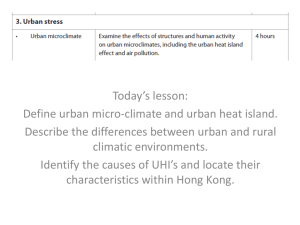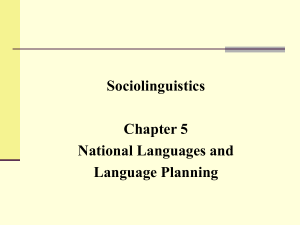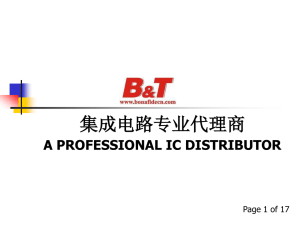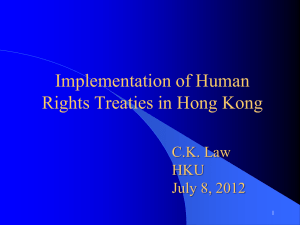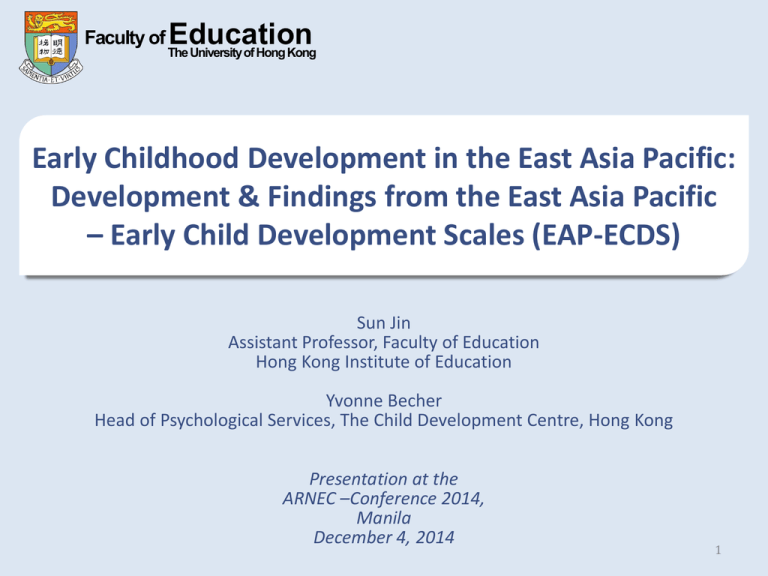
Faculty of Education
The University of Hong Kong
Early Childhood Development in the East Asia Pacific:
Development & Findings from the East Asia Pacific
– Early Child Development Scales (EAP-ECDS)
Sun Jin
Assistant Professor, Faculty of Education
Hong Kong Institute of Education
Yvonne Becher
Head of Psychological Services, The Child Development Centre, Hong Kong
Presentation at the
ARNEC –Conference 2014,
Manila
December 4, 2014
1
Faculty of Education
The University of Hong Kong
EAP-ECDS
A collaborative effort by
-UNICEF
-ARNEC
-Open Society Foundation
-Faculty of Education, University of Hong Kong
2
Faculty of Education
The University of Hong Kong
Faculty of Education
The University of Hong Kong
Overview
1. Rationale for developing the East Asia Pacific
– Early Child Development Scales (EAP-ECDS)
2. Process of Development
– Phases 1, 2 and 3
3.
4.
5.
6.
Overall Findings
Lessons Learned
Potential Uses
Conclusions
4
Faculty of Education
The University of Hong Kong
Rationale for Developing the EAP-ECDS
1. Need to invest in young children – UNICEF’S Early Learning
and Development Standards (ELDS)
• Standards are statements of expectation for “what children
should know and be able to do”
• Five Broad Domains of School Readiness have been widely
accepted:
•
•
•
•
•
Physical Health, Well-Being, and Motor Development
Social & Emotional Development
Approaches Toward Learning
Language, Literacy & Communication
Cognition and General Knowledge
5
Faculty of Education
The University of Hong Kong
Rationale for Developing the EAP-ECDS
2. Implementation of Standards
3. Emphasis on evidence-based decision making
• What are the differences between children who attend
and those who do not attend early childhood
programmes?
• How important is quality?
• Which programmes should be scaled up?
To answer these questions, we need a tool to measure
early childhood development but…
6
Faculty of Education
The University of Hong Kong
Rationale for Developing the EAP-ECDS
• There are no globally accepted tests for ECD
• Culturally and contextually appropriate assessment
of ECD is important to:
monitor child development in the context of poor
school readiness and learning outcomes
track the development of vulnerable and at-risk
children
analyse the impact of early childhood policies and
programmes on children
7
Faculty of Education
The University of Hong Kong
Phase I
• To select items to be used in a tool to assess early
child development in the EAP region
– These items should be based on the Early Learning and
Development Standards (ELDS) of countries in the region
8
Faculty of Education
The University of Hong Kong
9
Faculty of Education
The University of Hong Kong
Development of the Items
Converted indicators
to items
Selected indicators
in each category
Determined # of indicators
in each category
Developed categories +
sub-categories
Established an
Indicator Database
Form a 100-item measure
To construct a 100-item regionallysensitive measure
Based on the proportion of the total # of
indicators in each category
7 categories
1738 indicators for children aged 3, 4,
and 5 from seven countries’ ELDS
Focus on rationale and process
Faculty of Education
The University of Hong Kong
Converting indicators to items
Code
LA16
Sub-category
Draws/writes
without an
example
Indicator
selected
Countries
Draws a human
figure (head, eyes,
Philippines(4);
mouth, trunk,
Cambodia(5);
arms, legs, etc.)
Thailand(4;5);
without prompts
Ages
4, 5
Materials
1. A piece of paper; A pencil
Faculty of Education
Procedure
The University of Hong Kong
Assessor asks child to draw a complete picture of him
/ herself.
Instruction Here is a pencil and paper. I would like you to draw a
complete picture of yourself standing.
Scoring
Head and/or trunk plus
□ 0
□ 1
Criteria and one other feature.
Comments Recognizable arms and/or
legs.
□ 0
□ 1
Recognizable hands
and/or feet.
□ 0
□ 1
One recognizable facial
feature (eyes, mouth,
nose, or ears).
□ 0
□ 1
At least one additional
recognizable facial
feature (eyes, mouth,
□ 0
□ 1
nose, or ears)
Faculty of Education
The University of Hong Kong
Converting indicators to items
Indicators
Code Sub-category
Countries
Selected
Tells how to pay
respect to elders
(Ex. clapping
Cambodia,
hands, bowing,
Laos,
etc.).
Shows or uses
Mongolia,
SS01 respectful
Philippines,
Uses polite words
behavior
Thailand,
with adults (by
Vanuatu,
answering thank
Vietnam
you, hello, good
bye etc.).
Age
3;4;5
Materials
Two pictures of:
Faculty of Education
of Hong Kong
1.TheAUniversity
sitting
child and a standing adult in bus (can be
changed by country).
2. An adult giving a nicely wrapped gift to a child
(only two persons in picture)
Procedure Assessor shows one picture at a time and asks child
what the child in the picture should say.
Instruction 1. (for Picture 1) Look at this picture. Look at this
child. Here is a grandmother. What would you say
or do if you were the child?
2. (for Picture 2) In this picture, the adult is giving a
very nice gift to this child. What would you say to
the adult if you were this child?
Scoring
Correctly answered
□ 0
□ 1
Criteria and Question 1.
Comments
Correctly answered
□ 0
□ 1
Question 2.
Faculty of Education
The University of Hong Kong
• Revised feedback on draft categories, subcategories,
indicators and items
• HKU team developed items, scoring criteria and
instructional manual. How we did this? Iterative process
• Panel of experts reviewed drafts materials and
appropriateness of methods and suggested changes
Faculty of Education
The University of Hong Kong
Phase II: Pilot studies
1. To field-test items in three countries
2. To modify the Scales based on the results and
feedback
3. To develop a revised version of the Scales which can
be used in many countries in Phase III
16
Faculty of Education
The University of Hong Kong
Pilot study
Mongolia
Fiji
China
Modification
Send draft to
countries
Translation
& checking
Field trials
Field Consultancy Support
Faculty of Education
The University of Hong Kong
Questions for Phase II
• Evaluate the effectiveness of the Scales
– Reliability
• Cronbach’s alpha: > .70
– Validity
• Content validity: expert review
• Age validity: older children scoring significantly higher than
younger children
– Appropriateness
• Cross-cultural differences
• Item discrimination
• Item facility
18
Faculty of Education
The University of Hong Kong
Item Difficulty & Discrimination:
Cognitive Development
Top 5 Easiest Items
CD12_2
Sat on the chair
CD22_4
Correctly put the toy under the chair
CD12_1
Brought the block (or other small item) to the assessor
CD3_1
Correctly put one block inside the box
CD22_3
Correctly put the toy on the chair
Top 5 Hardest Items
CD22_2
Correctly put the toy on the left side of the chair
CD5_2
Correctly picked 7 blocks on the paper
CD17_3
Correctly arranged all the pictures in the right order
CD5_3
Correctly picked 15 blocks on the paper
CD5_4
Correctly picked 29 blocks on the paper
19
Faculty of Education
The University of Hong Kong
The Revised Scale after Phase II
1. Approaches to Learning
7 items
2. Cognitive Development
21 items
3. Cultural Knowledge and Participation
10 items
4. Language and Emergent Literacy
16 items
5. Motor Development
7 items
6. Health, Hygiene and Safety
9 items
7. Socio-Emotional Development
15 items
Total
85 items
20
Faculty of Education
The University of Hong Kong
Objective of Phase III
Validate the EAP-ECDS in 6 countries in the region
21
Faculty of Education
The University of Hong Kong
Sampling
• From June to December 2013, EAP-ECDS assessments were
carried out in six countries
• Samples included both boys and girls residing in urban and
rural settings, attending preschool programmes and those
who did not; the number of children assessed in each country
ranged from 900 to 1803
• Sampling in all countries were stratified by child’s Age, Gender
and Urbanicity
22
Faculty of Education
The University of Hong Kong
Country adaptations
• Translated versions of the EAP-ECDS Instruction Manual,
Scoring Form and Parent Questionnaire
Country
Translated versions in the
country’s native language(s)
Cambodia
Khmer
China
Chinese
Mongolia
Mongolian
Papua New Guinea
Tok Pisin
Timor-Leste
Tetum
Vanuatu
Bislama
23
Faculty of Education
The University of Hong Kong
Country adaptations: Item 15
Arrange picture according to temporal order
Cambodia
China
PNG
24
Faculty of Education
The University of Hong Kong
Country adaptations: Item 17
Predicts season or weather
Cambodia
Vanuatu
PNG
25
Faculty of Education
The University of Hong Kong
Country adaptations: Item 52
Letters, characters / symbols
Cambodia
China
大,小,人,山,水,日,月,木,树,手,牛,羊。
Mongolia
А, Н, О, М, Б, У, С, Э, Т, И, Р, Л;
26
Faculty of Education
The University of Hong Kong
Country adaptations: Item 54
Wordless picture book
Cambodia
Mongolia
China
Timor-Leste
27
Faculty of Education
The University of Hong Kong
Country adaptations: Item 61
Child in bathroom with a sink
Cambodia
China
Mongolia
Timor-Leste
PNG
Vanuatu
28
Faculty of Education
The University of Hong Kong
Country adaptations: Item 63
Signs
Cambodia
China
Vanuatu
29
Faculty of Education
The University of Hong Kong
Country adaptations: Item 72
Picture of a teddy bear sitting outside the front door of a local-type store
PNG
China
Vanuatu
30
Faculty of Education
The University of Hong Kong
Country adaptations: Item 77
A picture with national flags
Cambodia
Timor-Leste
China
PNG
Mongolia
Vanuatu
31
Faculty of Education
The University of Hong Kong
Country adaptations: Item 78
An adult throwing large amounts of garbage into a clean river
China
PNG
Vanuatu
32
Faculty of Education
The University of Hong Kong
Parent Questionnaire
• Demographic
• Information about the family
– Family asset
– Family members
– Family learning support
• The child’s early learning and development
• The child’s health and habit
33
Faculty of Education
The University of Hong Kong
Overall Findings
34
Faculty of Education
The University of Hong Kong
Important points
• These findings are based on six countries in our
region that vary widely in human development
indicators, size, early childhood policy, challenges
and opportunities.
• Countries varied in sampling procedures, and
samples varied in terms of preschool attendance.
• We did not make cross-country comparisons like in
the PISA, PIRLS, TIMMS – we think it is inappropriate
to do so.
35
Faculty of Education
The University of Hong Kong
Demographic and Human Development Indicators
in the six countries
36
Faculty of Education
The University of Hong Kong
Sample for EAP-ECDS validation
by country, age and gender
Country
China
Cambodia
Mongolia
Papua New
Guinea
TimorLeste
Vanuatu
Total
Age
3Y
4Y
5Y
3Y
4Y
5Y
3Y
4Y
5Y
3Y
4Y
5Y
3Y
4Y
5Y
3Y
4Y
5Y
Rural
Girls
Boys
88
85
89
89
88
92
60
59
51
58
67
47
103
102
104
105
104
104
173
170
181
188
226
213
96
97
100
100
101
96
69
93
95
102
127
127
1922
1927
Urban
Girls
Boys
110
104
105
107
106
106
214
188
214
197
199
238
104
105
104
105
105
102
99
95
114
79
98
108
98
108
101
94
99
98
6
8
21
12
17
17
1914
1871
Total
387
390
392
521
520
551
414
418
415
537
562
645
399
395
394
176
230
288
7634
37
Faculty of Education
The University of Hong Kong
Number of children with and without Early
Childhood Education (ECE) across countries
38
Faculty of Education
The University of Hong Kong
Scale Validation
• Cronbach’s alpha
• Content validity
• Comparisons across different domains and groups
– 3 (Age) × 2 (Gender) × 2 (Urbanicity) MANOVA
• Consistency between children’s performance and
parents’ assessment
• Item analysis
– Appropriateness: discrimination and facility
– Differential item function analysis: no systematic bias
– Item information curves and test information function
curves for each domain
39
Faculty of Education
The University of Hong Kong
Internal consistency of the EAP-ECDS domain
scores across countries
40
Faculty of Education
The University of Hong Kong
Items for parents’ rating of
children’s competence
Domain
Cognitive
Development
Socio-Emotional
Development
Motor Development
Language and
Emergent Literacy
Health, Hygiene, and
Safety
Cultural Knowledge &
Participation
Approaches to
Learning
Skill
Ability to learn new things and solve new
problems
Display social skills, such as showing
consideration for others and ability to
manage emotions
Ability to run and jump
Ability to hold chopsticks, spoons/pencils/pens
Language Skills
Practice healthy and hygienic habits
(e.g. washing hands independently)
Follow safety rules
(e.g., not touching hot/dangerous things)
Participate in important community events
(including festivals)
Ability to concentrate on learning new tasks
(exclude watching TV)
41
Faculty of Education
The University of Hong Kong
Correlations between parent ratings
and EAP-ECDS domain and total scores
42
Faculty of Education
The University of Hong Kong
Predicting early childhood development
in the East Asia Pacific
Coefficients and
95% confidence
intervals
Intercept
-7.40
(-13.69, -1.11)
Pre-school
6.52
attendance
(4.10, 8.76)
Household Asset
0.81
(0.53, 1.09)
Mother’s education 0.67
(0.50, 0.87)
Sex (Girl as
-1.0
reference)
(-1.54, -0.46)
Age
12.28
(11.95, 12.62)
P-values
0.02
<0.001
<0.001
<0.001
<0.001
<0.001
43
Faculty of Education
The University of Hong Kong
Age, gender, urban-rural differences in
total EAP-ECDS score across countries
• 5Y > 4Y > 3Y
• Gender imbalance
• Urban-rural imbalance
44
Faculty of Education
The University of Hong Kong
Regression coefficients from multi-level model
for global and country specific effects
of preschool attendance on the EAP-ECDS
Pre-School Effects
p-value
Global
6.52
(4.04, 9.01)
<0.001
Cambodia (KHM)
9.62
(5.83, 13.54)
<0.001
China (CHN)
7.37
(4.55, 10.09)
<0.001
Mongolia (MNG)
6.64
(3.93, 9.41)
<0.001
Papua New Guinea (PNG)
7.29
(3.59, 10.86)
<0.001
Timor-Leste (TLS)
2.38
(-1.11, 5.99)
0.188
Vanuatu (VUT)
5.92
(2.69, 9.58)
<0.001
48
Faculty of Education
The University of Hong Kong
Country-specific effects of the impact of attendance in an early
childhood programme on early child development and learning
49
Faculty of Education
The University of Hong Kong
Participation in ECCE
• Urban-rural disparities in participation
• Older children and those of better-educated parents
were more likely to be enrolled in an early learning
programme than other children.
• In almost all countries, the children who attended
ECCE went to kindergarten (In Timor-Leste, about
half went to community/drop-in centres).
50
Faculty of Education
The University of Hong Kong
Home Learning Environments
• 30 to 60 per cent of parents reported engaging in
early learning-related activities with children at
home.
• Educated parents tended to support early learning at
home more than other parents.
• Mothers were more involved than other family
members with the exception of Timor-Leste
51
Faculty of Education
The University of Hong Kong
Children’s Health and Habits
• Almost all children were vaccinated
• Age was best predictor of health facilitation practices
(taking children to the clinic)
• Older children and girls tended to have better health
and hygiene habits than other children
52
Faculty of Education
The University of Hong Kong
Reported Health Problems
• Urban parents and better educated mothers were
more likely to report that their children had health
problems.
• It is not clear whether
– urban children suffer poorer health
– urban parents are more aware of children health
issues, and are more likely to report health
concerns, or
– facilities are not available in rural areas
53
Faculty of Education
The University of Hong Kong
Potential uses
to use evidence to
- decrease urban/rural gaps;
- decrease gender imbalances;
- promote parental involvement;
- advocate early childhood education and care;
- guide ECCE curriculum development/ review;
- …
54
Faculty of Education
The University of Hong Kong
Lessons learned
• need a low-resource tool (hard to access areas!)
• never skip language selection & (back-)
translation process (meanings get lost)
• be culturally appropriate (item flexibility vs.
standardisation)
• consider direct vs. indirect assessment
• train tool users/ administrators (training? how?)
55
Faculty of Education
The University of Hong Kong
Conclusions
• First regional tool
• Bottom-up approach to development of assessment
tool
• Enormous resources put into ensuring contextsensitivity of items, and developing a
psychometrically robust tool
• There are many challenges associated with ensuring
cross-cultural equivalence of items
56
Faculty of Education
The University of Hong Kong
Thank you for your attention!

